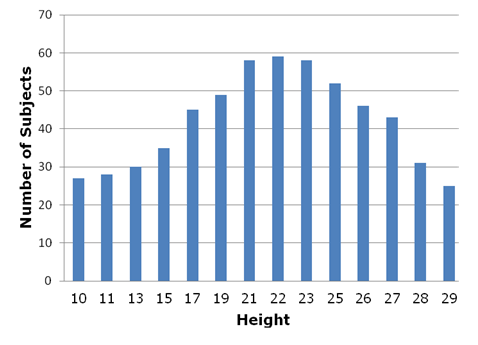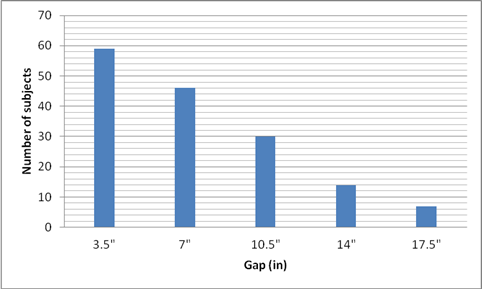The Impact of Transfer Setup on the Performance of Independent Transfers: Phase I Final Report
Side guard protocol
One-hundred and thirteen (113) subjects were tested under this protocol. As described above, side guard height was adjusted to be 6” higher than the WMD seat when the platform was level or lowered and 6” above the platform height when the platform was raised. 42% (47/113), CI[30%,47%] of the subjects could not achieve a transfer with the side guard in place and with the platform at level with the WMD. When the conditions were changed (height raised/lowered or gap introduced) the transfers were unattainable to up to 47% (53/113), CI[37%,55%] of the participants. Of the 60 subjects that were able to transfer to a higher level than their own WMD, 98% (59/60), CI[91%,99%] were able to transfer to height of 22” (55.9cm) (Figure 12 and Table 8). At the extreme ranges of platform heights 22% (25/113), CI[24%,31%] were able to transfer to the highest height of 29” (73.7 cm). 24% (27/113), CI[17%,32%] were able to transfer to the lowest height of 10” (25.4cm).
When a gap was introduced with the side guard 60 subjects were able to attain this transfer. 41% (46/113), CI[34%,52%] were able to transfer at a height level with their WMD and a gap of 7" (17.8 cm). Only6% (7/113), CI[4%,13%] could transfer with a 17.5” (40.6cm) or greater gap (Figure 13 and 9).

Figure 12. Number of subjects (y-axis) able to transfer at different heights (x-axis) with the side guard in place.
Table 8 . Percentage of subjects that were able to attain a certain height in the side guard protocol
|
Height (in) |
% Subjects Side guard |
|
10 |
24% |
|
11 |
25% |
|
12 |
26% |
|
13 |
27% |
|
14 |
27% |
|
15 |
31% |
|
16 |
35% |
|
17 |
40% |
|
18 |
41% |
|
19 |
43% |
|
20 |
48% |
|
21 |
51% |
|
22 |
52% |
|
23 |
51% |
|
24 |
46% |
|
25 |
46% |
|
26 |
41% |
|
27 |
38% |
|
28 |
27% |
|
29 |
22% |
Table 8 Alternative Text Description: This table gives the percentage of subjects that were able to attain a certain height during the side guard protocol. There are two columns; the left one lists the transfer height, the right one lists the percentage of subjects that were able to attain that height.

Figure 13. Number of subjects (y-axis) able to transfer with different gaps (x-axis) at a level transfer with the side guard in place
Table 9 . Percentage of subjects that were able to attain a certain gap in the side guard protocol
Gap |
% Subjects |
|
3.5" |
52% |
|
7" |
41% |
|
10.5" |
27% |
|
14" |
12% |
|
17.5" |
6% |
Table 9 Alternative Text Description: This table gives the percentage of subjects that were able to attain a transfer with a certain gap during the side guard protocol. There are two columns; the left one list the gap distances; the right one list the percentages of subjects that were able to attain the transfer at that gap distance. Forty-one percent of the subjects were able to transfer at a height level with their WMD and a gap of 7 inches. Only 6% could transfer with a 17.5 inch or greater gap.
Subjects that could not attain the protocol
In addition to the 4 subjects that could not attain any of the protocols, forty-three additional subjects could not attain the side guard protocol. Table 10 contains basic demographic characteristics of these 43 subjects.
Table 10 . Demographics of the subjects that could not attain protocol side guard.
| Diag-nosis |
Gender |
Age |
Weight (lbs) |
Height (lbs) |
Years using WMD |
Type of WMD |
AT for transfers |
|
SCI T7-C |
M |
40 |
142 |
67 |
15 |
M |
|
|
SCI T6-C |
M |
47 |
216 |
74 |
1 |
M |
|
|
SCI T11 –C |
M |
34 |
130 |
70 |
2 |
M |
|
|
MS |
M |
52 |
203 |
71 |
10 |
P |
Transfer board |
|
RSD |
F |
37 |
118 |
62 |
5 |
M |
Transfer board |
|
MS |
M |
62 |
180 |
60 |
37 |
S |
|
|
SCI |
M |
56 |
165 |
62 |
22 |
M |
|
|
SCI T5-I |
M |
57 |
160 |
72 |
16 |
M |
|
|
AK amputee |
M |
62 |
245 |
69 |
11 |
P |
|
|
SCI L1 –C |
M |
65 |
150 |
68 |
25 |
M |
|
|
SCI L3-I/LAKA |
M |
65 |
211 |
72 |
13 |
P |
|
|
SCI C5 –I |
M |
53 |
160 |
71 |
26 |
M |
Transfer board |
|
SCI L4 –I |
M |
71 |
228 |
70 |
10 |
P |
|
|
SCI T11-C |
M |
65 |
195 |
70 |
4 |
P |
Transfer board |
|
SCI T11- I |
M |
46 |
194 |
68 |
16 |
M |
|
|
MS |
M |
58 |
205 |
69 |
20 |
M |
Transfer board |
|
SCI T3 –I |
M |
55 |
225 |
56 |
10 |
M |
|
|
SCI T12 –C |
M |
61 |
150 |
70 |
4 |
M |
|
|
MS |
F |
61 |
125 |
69 |
N/A |
M |
|
|
CP |
M |
57 |
140 |
68 |
52 |
P |
|
|
SCI T12-I |
M |
54 |
190 |
72 |
30 |
M |
|
|
MS |
M |
36 |
160 |
63 |
9 |
M |
|
|
Post polio |
F |
66 |
250 |
62 |
56 |
M |
|
|
SCI C6 –I |
M |
29 |
120 |
70 |
5 |
M |
|
|
SCI T5 –I |
M |
31 |
170 |
73 |
10 |
S |
|
|
SCI L3 -I |
M |
39 |
287 |
69 |
15 |
M |
|
|
SCI T4- C |
M |
35 |
165 |
72 |
17 |
M |
|
|
CP |
F |
22 |
140 |
63 |
12 |
M |
|
|
Spina Bifida |
F |
20 |
110 |
60 |
20 |
M |
|
|
CP |
53 |
M |
190 |
72 |
24 |
P |
|
|
SCI T7 -C |
M |
63 |
115 |
63 |
24 |
M |
|
|
CP |
M |
46 |
158 |
69 |
16 |
S |
|
|
SCI T6-C |
M |
46 |
158 |
69 |
16 |
M |
|
|
Doble AKA-Stroke |
M |
55 |
250 |
72 |
4 |
P |
|
|
SCI T3-C |
M |
27 |
110 |
67 |
12 |
M |
|
|
SCI C7-I |
F |
48 |
170 |
65 |
3 |
M |
|
|
SCI L1- C |
F |
55 |
115 |
66 |
30 |
M |
|
|
SCI C6- I |
F |
33 |
180 |
77 |
5 |
M |
|
|
CP |
F |
41 |
160 |
57 |
40 |
M |
|
|
SCI T12-I |
M |
58 |
N/A |
74 |
28 |
M |
|
|
SCI C5 – I |
M |
49 |
161 |
70 |
25 |
M |
|
|
RA |
F |
44 |
230 |
64 |
18 |
M |
Transfer board |
|
SCI T7-C/TBI |
M |
29 |
200 |
70 |
6 |
M |
Transfer board |
|
TBI |
M |
43 |
180 |
70 |
28 |
P |
|
|
SCI T4-C |
M |
41 |
170 |
67 |
21 |
P |
Transfer board |
|
Spina Bifida |
F |
40 |
145 |
59 |
29 |
M |
|
|
SCI T11 -I |
F |
24 |
235 |
72 |
3 |
M |
Transfer board |
|
Total |
12 F |
47±13 |
175±42 |
68±5 |
18±12 |
34M |
10 used TB |
|
|
35 M |
3 S |
Abbreviation: SCI-spinal cord injury, C-complete, I-incompelte, MS- multiple sclerosis, RSD-reflex sympathetic dystrophy, CP-cerebral palsy, AK-above knee, RA- rheumatoid arthritis, N/A data not reported.
Table 10 Alternative Text Description: This table gives the demographics of the subjects that could not attain the side guard protocol. Forty-three subjects could not attain the side guard protocol.

User Comments/Questions
Add Comment/Question